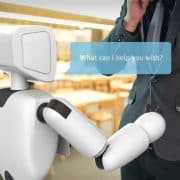The Top 10 Technology Trends In Retail: How Tech Will Transform Shopping In 2020
Technology is making its mark in just about every industry we know of. It helps create efficiencies, save money and provide better products and services. In retail for example, not only is technology making it easier for consumers to shop in store, online and on their mobile devices, but the softwares and processes are helping retail companies do business better. Strategic business & technology advisor Bernard Marr shared an article on Forbes predicting the top trends we might see in retail in 2020.
- Extended Reality – “Virtual and augmented reality offer retailers several ways to enhance the customer experience. From browsing products to virtually “trying them on,” extended reality is already in use by many retailers today such as Tilly’s, Ikea and Treasury Wines Estates. In the future, extended reality will eventually enable consumers to be able to share their virtual reality shopping experience with others.”
- Predictive Analytics (Big Data) – “Retail organizations have never had an issue collecting lots of data, but analyzing it and using the data to solve problems or create new solutions has been a struggle. Predictive analytics changes that. Now retailers can be proactive about the future by analyzing consumer behavior and trends from the past. Predictive analytics helps retailers be smarter, more efficient, and reduce costs.”
- Micro Moments – “Retailers who can meet customers “in the moment” have a powerful advantage. Thanks to direct digital access to consumers and powerful analytics capabilities, businesses can capture moments and help customers during their moment of need and even anticipate what a customer might need before they even know it.”
- Recommendation Engines – Another powerful tech tool for retailers is recommendation engines that help customers find things they never knew they needed and to help funnel options to a consumer at relevant times in their shopping journey. Retailers get to benefit from higher cart sales and improved customer satisfaction thanks to the ease of use. Amazon, Netflix, and Spotify are the recommendation engines you might be most familiar with, but many other retailers such as Best Buy use them too.
- Order Fulfilment Automation – “By the end of 2025, more than 580,000 autonomous mobile robots (AMR) will be deployed to help warehouses fulfill customer orders. Many retailers are scrambling to adjust to the “Amazon Effect” and are exploring order fulfillment automation to try to increase the speed and flexibility of operations in order to compete with Amazon. This automation can significantly reduce order processing times.”
- Face Recognition – “Many of the most successful retailers have online and offline presences. Facial recognition technology helps retailers proactively battle shoplifting and retail crime. In addition, it can bring the personalized online shopping experience to the brick-and-mortar location. When a customer is identified through facial recognition technology, the store staff can better respond to that customer’s unique needs.”
- Stock Management – “Automated warehouses help improve inventory control. Rather than wait for manual inventories, smart robotics and computer systems keep reliable stock data in real-time. This accurate data helps retailers manage stock flow, make solid predictions, smart decisions, and forecasting that help improve the store’s bottom line.”
- Robotic Store Assistants – “Another tech trend that’s changing shopping is robotic store assistants. Robots can help shoppers find the merchandise they are looking for and answer questions. They can even email special offers or coupons. Lowe’s has the LoweBot that helps with in-store customer service.”
- Customer Chat Bots – “There has been rapid adoption of messaging-based customer service bots across retail. Messaging has become the preferred customer service channel, so call volume will be reduced. Artificial intelligence bots will be able to improve the customer journey pre- and post-sales by lowering cart abandonment and help customers solve problems after the sale without human intervention.”
- Internet of Things (IoT) and Smart Equipment – “The Internet of Things and smart equipment will transform the shopping experience. Thanks to the volumes of data we have available and the ability to process it, consumers can receive a personalized shopping experience that wasn’t possible before. Today’s consumers want experiences that include personalization and information to help them make decisions.”



